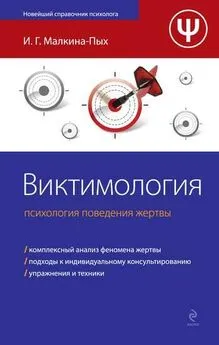Ирина Малкина-Пых - Терапия пищевого поведения
- Название:Терапия пищевого поведения
- Автор:
- Жанр:
- Издательство:неизвестно
- Год:неизвестен
- ISBN:нет данных
- Рейтинг:
- Избранное:Добавить в избранное
-
Отзывы:
-
Ваша оценка:
Ирина Малкина-Пых - Терапия пищевого поведения краткое содержание
Избыточный вес остается актуальной проблемой, несмотря на то, что чуть ли не каждый месяц появляется новое средство или метод, позволяющие гарантированно похудеть. Огромная индустрия производства всевозможных таблеток, поясов для похудения и других чудодейственных способов сбросить вес процветает, а масса тела среднестатистического россиянина год от года увеличивается.
Одна из причин сложившейся ситуации состоит в том, что большинство способов нормализации веса устраняют следствие, а не причину. Между тем психология и психотерапия располагают вполне реальными и весьма многочисленными подходами и методами, способными помочь человеку избавиться от переедания и лишнего веса. Именно психотерапия дает наиболее надежные результаты в преображении собственной внешности. И в развитых странах, где еще в прошлом столетии отошли от многих способов лечения, до сих пор практикуемых в России, для снижения веса обычно обращаются к психотерапевтам. Именно психотерапия нормализует пищевое поведение и помогает отказаться от старых привычек.
В справочнике в достаточном объеме представлены теоретические вопросы психологии пищевой зависимости, но в первую очередь это сборник техник психотерапии, точнее сказать, упражнений, которые психолог (психотерапевт, консультант) может использовать в своей практической работе. Эта книга – руководство для психологов и консультантов, работающих в различных учреждениях (государственных и частных клиниках, больницах и общественных центрах здоровья) с пациентами, страдающими нарушениями пищевого поведения и алиментарным (связанным с перееданием) ожирением.
Терапия пищевого поведения - читать онлайн бесплатно ознакомительный отрывок
Интервал:
Закладка:
Crisp A.H. Anorexia nervosa: Let me be. London: Academic Press, 1981.
Cutting T.M., Fisher J.O., Grimm-Thomas K., Birch L.L. Like mother, like daughter: familial patterns of overweight are mediated by mothers’ dietary disinhibition // Am. Clin. Nutr., 1999, vol. 69, pp. 608–613.
Dare C., Crowther C. Living dangerously: psychoanalytic psychotherapy of anorexia nervosa. In G. Szmukler, C. Dare, J. Treasure (Eds.), Eating Disorders: Handbook of Theory, Treatment and Research. Chichester: John Wiley Sons, 1995.
Dare C., Eisler I. Family therapy. In G. Szmukler, C. Dare, J. Treasure (Eds.), Handbook of eating disorders: Theory, treatment and research. London: Wiley, 1995.
Davis C., Shapiro C. M., Elliott S., Dionne M. Personality and other correlates of dietary restraint: An age by sex comparison // Personality and Individual Differences, 1993, vol. 14, pp. 297–305.
Davis C., Yager J. Transcultural aspects of eating disorders: A critical literature review // Culture, Medicine, and Psychiatry, 1992, vol. 16, pp. 377–394.
De Jong W. Obesity as a characterological stigma // Psychological Reports, 1993, vol. 73, pp. 963–970.
De Zwaan M., Nutzinger D.O., Schonbeck G. Binge eating in overweight women // Compr. Psychiatry, 1992, vol. 33, pp. 256–261.
De Fronzo R.A., Ferrannini E. Insulin resistance: a multifaceted syndrome response for NIDDM, obesity, hypertension, dyslipidemia, and atherosclerotic cardiovascular disease // Diabetes Care, 1991, vol. 14, pp. 173–194.
Descutner C.J., Thelen M.H. Development and validation of the Fear of Intimacy scale // Psychological Assessment, 1991, vol. 3, pp. 377–383.
Deutsch F. Symbolization as a formative stage of the conversion process. In: F. Deutsch (Ed.), On the mysterious leap from the mind to the body. – New York: Intern. Univ. Press, 1959.
Deutsch F. The psychosomatic concept in psychoanalysis. – New York: Intern. Univ. Press, 1953.
Devlin M.J. Treatment of binge eating disorder with psychotherapy and medication. Proceeding of the 7-th international conference on eating disorders, New York, April, 1996.
Devlin M.J., Walsh B.T., Spitzer P. L., Hasin D. Is there another binge eating disorder? A review of the literature on overeating in the absence of bulimia nervosa//Am. J. Psychiatry, 1992, vol. 11(4), pp. 333–340.
Dokter D. (Ed.), Fragile board: Arts therapies and clients with eating disorders. – London and Pennsylvania: Jessica Kingsley, 1994.
Dolan B., Lacey H. Bulimia in British blacks and Asians // Br. J. Psychiatry, 1988, vol. 152, pp. 73–86.
Drewnowski A. Cognitive aspects of food preference and food aversion // Bull. Psychonom. Soc., 1991, vol. 29(3), pp. 261–264.
Drewnowski A., Kurth C.L., Krahn D.D. Effects of body image on dieting, exercise, and anabolic steroid use in adolescent males // International Journal of Eating Disorders, 1995, vol. 17, pp. 381–386.
Dritschel B., Cooper, P.J., Charnock D. A problematic counter-regulation experiment: Implications for the link between dietary restraint and overeating// Int. J. Eat. Disord., 1993, vol. 13 (3), pp. 297–304.
DSM-IV. Diagnostic and Statistical Manual of Mental Disorder (DSM-IV) (4-th ed.). Washington, DC: American Psychological Association, 1994.
Dulicai D. Movement therapy with families // The Arts in Psychotherapy, 1984, vol. 4, pp. 77–80.
Eating disorders and obesity: a comprehensive handbook / Eds. Fairburn C.G., Brownell K.D. – 2-nd ed. – The Guilford Press, 2002.
Elam K. Semiotics of Theatre and Drama. – London: Routledge, 1988.
Eldredge K.L., Agras W.S. Weight and shape overconcern and emotional eating in binge eating disorder // Int. J. Eat. Disord., 1996, vol. 19, pp. 73–82.
Eldredge K.L., Locke K. D., Horowitz L. M. Patterns of interpersonal problems associated with binge eating disorder// Int. J. Eat. Disord., 1998, vol. 23(4), pp. 383–389.
Ellis A., Grieger R. (Eds.) Handbook of rational-emotive therapy. – New York: Springer, 1977.
Ellis A., Mclnerney J., DiGuiseppe R., Yeager R. Rational-emotive therapy with alcoholics and substance abusers. – New-York: Pergamon, 1988.
Ellis A.E. Humanistic psychotherapy. – NY: McGraw-Нill Paperbacks, 1973.
Ellis A.E. Reason and emotion in psychotherapy. – New York: Lyle Stuart, 1962.
Ellis A.E., Dryden W. The practice of rational-emotive therapy. – New York: Springer, 1987.
Engel G.L., Schmale A.Jr. Psychoanalytic theory of somatic disorder: Conversion, specificity, and the disease onset situation // J. Am. Psychoanal. Assoc., 1967, vol. 15, pp. 344–352.
Espenak L. Dance therapy, theory and application. Springfield: Charles С Thomas, 1981.
Espmark S. Psychological aspects of obesity // Reprod life: Proc. 10-th Int. Congr. Psychosomat. Obstet. and Gynaecal., Stockholm, 14–17 June, pp. 1992. – Carnforth., Parc Ridge (N.J.), 1992. – P. 243–249.
Fairburn C.G. A cognitive and behavioural approach to the management of bulimia // Psychol. Med., 1981, vol. 11, pp. 707–711.
Fairburn C.G., Agras W.S., Wilson G.T. The research on the treatment of bulimia nervosa: practical, and theoretical implications. In Anderson G.H., Kennedy S.H. (Eds), The Biology of Feast and Famine: Relevance to Eating Disorders. San Diego, Academic Press, 1992.
Fairburn C.G., Jones R., Peveler R.C., Carr S.J., Solomon R.A., O’Connor M.E., Burton J., Hope R.A. Three psychological treatments for bulimia nervosa // Arch. Gen. Psychiatry, 1991, vol. 48, pp. 463–469.
Fairburn C.G., Jones R., Peveler R.C., Hope R.A., O’Connor M. Psychotherapy and bulimia nervosa: The longer-term effects of interpersonal psychotherapy, behavior therapy and cognitive behavior therapy // Arch. Gen. Psychiatry, 1993, vol. 50, pp. 419–428.
Fairburn C.G., Kirk J., O’Connor M., Cooper P.J. A comparison of two psychological treatments for bulimia nervosa // Behav. Res. Ther., 1986, vol. 24, pp. 629–643.
Fairburn C.G., Marcus M.D., Wilson G.T. Cognitive-behavioral therapy for binge eating and bulimia nervosa: A comprehensive treatment manual. In Fairburn CG, Wilson GT (Eds.), Binge Eating: Nature, Assessment, and Treatment. New York, Guilford Press, 1993.
Fairburn C.G., Norman P.A., Welch S.L., O’Connor M.E., Doll H.A., Peveler R.C. A prospective study of outcome in bulimia nervosa and the long-term effects of three psychological treatments // Arch. Gen. Psychiatry, 1995, vol. 52, pp. 304–312.
Faith M.S., Schare M.L. The role of body image in sexually avoidant behavior// Archives of Sexual Behavior, 1993, vol. 22 (4), pp. 345–356.
Federn P. Ego psychology and the psychoses. – New York: Basic Books, 1952.
Federn P. Some variations in Ego-feeling // Int. J. Psychoanal., 1926, vol. 7, pp. 434–444.
Fenichel O. Problems of psychoanalytic technique. – Albany, NY: Psychoanalytic Quarterly, 1941.
Fenichel O. The psychoanalytic theory of neurosis. – New York: Norton, 1945.
Ferguson T. J. Eyre H.L., Ashbaker M. Unwanted identities: a key variable in shame-anger links and gender differences in shame// Sex Roles, 2000, vol. 42, nn. 3–4, pp. 133–157.
Fernstrom J.D., Wurtman R.J. Brain serotonin content: Physiological dependence on plasma tryptophan levels // Science, 1971, vol. 173, pp. 149–152.
Fichter M.M., Leibl K., Rief W., Brunner E., Schmidt-Auberger S., Engel R.R. Fluoxetine versus placebo: A double-blind study with bulimic inpatients undergoing intensive psychotherapy // Pharmacopsychiatry, 1991, vol. 24, pp. 1–7.
Fichter M.M., Quadflieg N., Gnutzmann A. Binge eating disorder: Treatment outcome over a 6-years course // J. Psychosom. Res. 1998, vol. 44, pp. 385–405.
Fichter M. Psychological therapies in bulimia nervosa. In M. M. Fichter (Ed.), Bulimia nervosa: Basic research, diagnosis and therapy. – Chichester, England: Wiley, 1990.
Fineman S. Unemployment: Personal and Social Consequence. – London: Tavistok, 1987.
Fineman S. White collar unemployment: Impact and Stress. – London: Chichester, 1983.
Fisher S. Body Consciousness. – New Jersy: Prentic-Hall, 1973.
Fisher S. Body experience in fantasy and behavior. – New York: Appleton-Century-Crofts, 1970.
Fisher S. Development and structure of the body image. (Vol’s. 1 2). – Hillsdale, NJ: Erlbaum, 1986.
Fisher S., Cleveland S. Body Image and Pesonality. – Princeton: Princeton Univ. Press, 1958.
Fogiel M. (Ed.). The psychology problem solver. – New York: REA, 1980.
Fombonne E. Eating disorders: Time trends and possible explanatory mehanisms. In M. Rutter, D. J. Smith (Eds.), Psychosocial disorders in young people. Chichester, England: Wiley, 1995.
Franko D. L. et al. The bulimic automatic though test // J.Clin. Psychol., 1992, vol. 48(4), pp. 505–509.
Franzen U., Florin I., Schneider S., Meier M. Distorted body image in bulimic women // Journal of Psychosomatic Research, 1988, vol. 32, pp. 445–450.
Franzoi S. L., Shields S. A. The Body Esteem Scale: Multidimensional structure and sex differences in a college population // Journal of Personality Assessment, 1994, vol. 48, pp. 173–178.
Fredrickson B.L., Roberts T.-A., Noll S.M., Quinn D.M., Twenge J.M. That swimsuit becomes you: Sex differences in self-objectification, restrained eating, and math performance // Journal of Personality and Social Psychology, 1998, vol. 75, pp. 269–284.
Freeman C. Cognitive therapy. In G. Szmukler, C. Dare, J. Treasure (Eds.), Handbook of eating disorders: Theory, treatment and research. – Chichester, England: Wiley, 1995.
Freeman R.J., Beach, B., Davis, R., Solyom L. The prediction of relapse inbulimia nervosa // Journal of Psychiatric Research, 1985, vol. 19, pp. 349–353.
Freud S. (1962) The Ego and the Id. London: Hogarth Press. Original edition, 1923.
Freyberger H. «Symptom», «Konflikt» und «Personlichkeit» in der Behandlung psychosomatischer Patienten // Prax. Psychother., 1976b, 3: 121–131.
Freyberger H. Psychosoziale Probleme bei erzinfarktpatienten // Therapiewoche. 1976a, 26: 5510–5514.
Freyberger H., Struwe H. Psychosomatische Aspekte der Fetsucht // Psyche (Stuttg.), 1962/1963, 16: 561–578.
Friedman K.E., Reichmann S.K., Costanzo P.R., Musante G. J. Body image partially mediates the relationship between obesity and psychological distress // Obes. Res., 2002, vol.10(1), pp. 33–41.
Friedman M., Rosenman R. H. Association of specific overt behavior pattern with blood and cardiovascular findings // J. Amer. Med. Ass., 1959, vol. 169, pp. 345–362.
Fryer S., Waller G., Kroese B. S. Stress, coping, and disturbed eating attitudes in teenage girls // International Journal of Eating Disorders, 1997, vol. 16, pp. 427–436.
Furumoto L. Rearing К. М. Construing anorexia nervosa (1940–1980): The psychoanalysists, the behaviorists, and Hilde Bruch. In I. Lubek, R. van Hezewijk, G. Pheterson, C. W. Tolman, (Eds.), Trends and issues in theoretical psychology. New York: Springer, 1995.
Gallant D., Alcoholism: a guide to diagnosis, intervention, and treatment. New-York: Norton, 1987.
Gangley R. M. (1988). Emotional eating and how it relates to dietary restraint, disinhibition, and perceived hunger // International Journal of Eating Disorders, 1988, vol. 7, pp. 635–647.
Garcia-Borreguero D., Jacobsen F.M., Murphy D.L., Joseph-Vanderpool J.R., Chiara A., Rosenthal N.E. Hormonal responses to the administration of m-chlorophenylpiperazine in patients with seasonal affective disorder and controls // Biol. Psychiatry., 1995, vol. 37(10), pp. 740–749.
Garfinkel P.E., Garner D. M. Perceptions of the body in anorexia nervosa. In K.M. Pirke, D. Ploog (Eds.), The psychobiology of anorexia nervosa. Berlin: SpringerVerlag, 1984.
Читать дальшеИнтервал:
Закладка:










